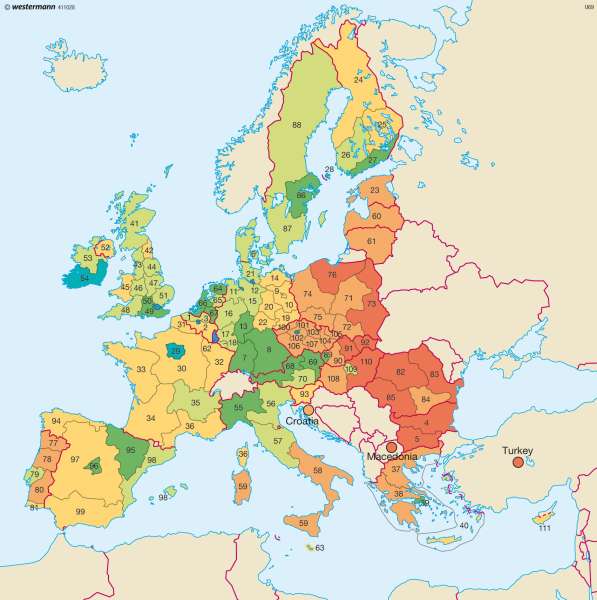EU — Regional economic power
Europe - European regions
978-3-14-100790-9 | Page 41 | Ill. 3

Information
The expansion of the EU to the south and east exacerbated the disparity among the economies of the Member States. The most prosperous countries in 2006 were Luxembourg, Ireland, the Netherlands and Austria, while Poland and the two newest Member States of Romania and Bulgaria ranked lowest. Germany, in fifth place in 1991, slipped to tenth in 2006. The Benelux countries, Ireland, Great Britain, Austria and the Nordic countries now enjoy a higher level of prosperity than Germany. Economic productivity and wealth also vary from one region to another within individual countries. The prosperity gradient correlates closely with the existing interregional differences in economic structure.Despite reservations with respect to its value as a criterion for comparison, regional differences in prosperity are often expressed in terms of gross domestic product, which is defined as the value of all goods and services produced in a region during a specified period of time. The conversion of GDP to purchasing power standards (PPS) takes regional differences in the cost of living into account and thus provides a more accurate picture of regional economic strength. Intra-regional income disparities are not reflected, however.
With several notable exceptions, including certain parts of Finland and Ireland, a marked income gradient can be identified from the rich regions of Central Europe to the much poorer areas on the fringes of the EU. Far less pronounced in contrast are the disparities within individual countries, although there are exceptions to this rule as well. Thus in Italy and Ireland, for example, there are significant prosperity gaps between north and south and south and north, respectively. Nearly everywhere in Europe, productivity and purchasing power are much higher in regions around national capitals than in outlying rural areas. In Germany, the gap between the old and new states can be traced to the different economic systems which prevailed during the years preceding reunification in 1990.
While the economic strength of the three nations which acceded to the EU in 1995, Austria, Sweden and Finland, is within the average range, the disparity in economic development within the EU became much more pronounced following the admission of the countries of Eastern and South-eastern Europe. At the present time, the Member States in Eastern Europe rank lowest in terms of economic strength, while purchasing power in Portugal is only marginally higher. A comparison of purchasing power standards illustrates the severity of these differences between rich and poor countries. Purchasing power in Luxembourg, which topped the list in 2006, was eight times that of Bulgaria, which ranked last.
A comparison of the relative distribution of employment in the three economic sectors to GDP in the individual EU Member States reveals that a high percentage of the labour force employed in agriculture correlates closely with low GDP, whereas income and productivity levels are significantly higher in industrial and service-oriented regions.
H. Müller, F.-J. Kemper; U: J. Southard




